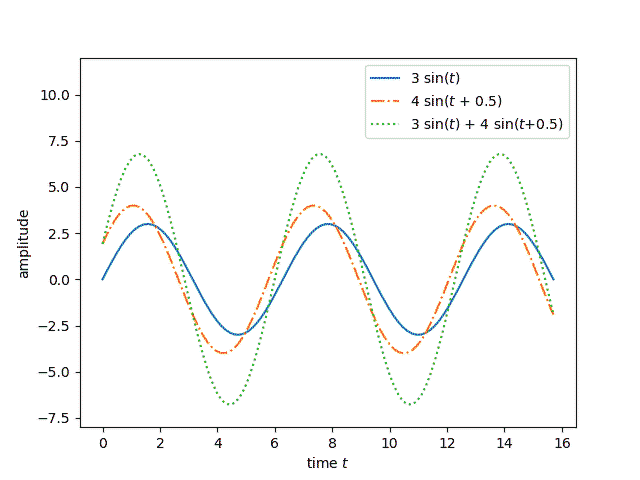Adding phase-shifted sine waves
Suppose you have two sinusoidal functions with the same frequency but with different phases and different amplitudes:
f(t) = A sin(t)
and
g(t) = B sin(t + ).
Then their sum is another sine wave with the same frequency
h(t) = C sin(t + ).
Note that this includes cosines as a special case since a cosine is a sine with phase shift = 90.

This post will
- prove that the sum of sine waves is another sine wave,
- show how to find its amplitude and phase, and
- discuss the significance of this result in signal processing.
Note f + g and h both satisfy the second order differential equation
y" = - ^2 y
Therefore if they also satisfy the same initial conditions y(0) and y(0) then they're the same function.
The functions f + g and h are equal at 0 if
B sin() = C sin().
and their derivatives are equal at 0 if
A + B cos() = C cos().
Taking ratios says that
tan() = B sin() / (A + B cos())
or
= arctan( B sin() / (A + B cos()) ).
Once we have , we solve for C and find
C = B sin() / sin().
Special case of sine and cosineLet's look at the special case of = 90, i.e. adding A sin(t) and B cos(t). Then sin() = 1 and cos() = 0, and the equation for simplifies to
= arctan(B/A).
If an angle has tangent B/A, then it's sine is B / (A^2 + B^2), and so we have
C = (A^2 + B^2).
Linear time invariant (LTI) systemsA linear, time-invariant system can differentiate or integrate signals. It can change their amplitude or phase. And it can add two signals together.
It's easy to see that changing the amplitude or phase of a signal doesn't change its frequency. It's also easy to see that differentiation and integration of sine waves doesn't change their frequency. But it's not as clear that adding two sines with the same frequency doesn't change their frequency. Here we've shown that's the case.
Bode plots are a way to show how an LTI system changes in response to changes in its inputs. These plots show what happens to the amplitude and to the phase. They don't need to show what happens to the frequency because the frequency doesn't change.
More signal processing postsThe post Adding phase-shifted sine waves first appeared on John D. Cook.